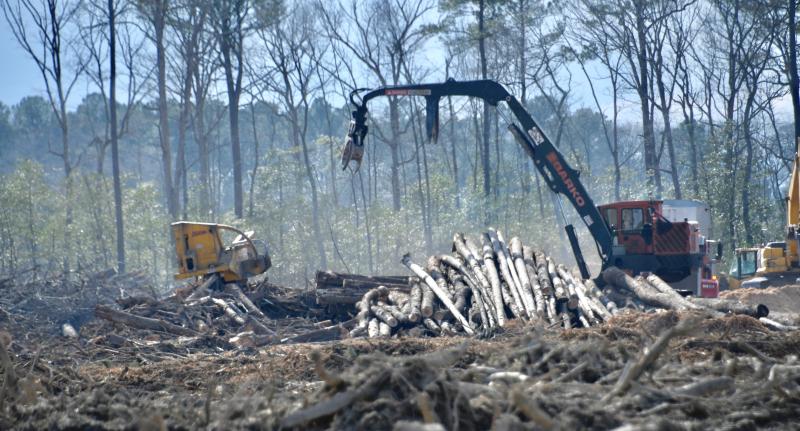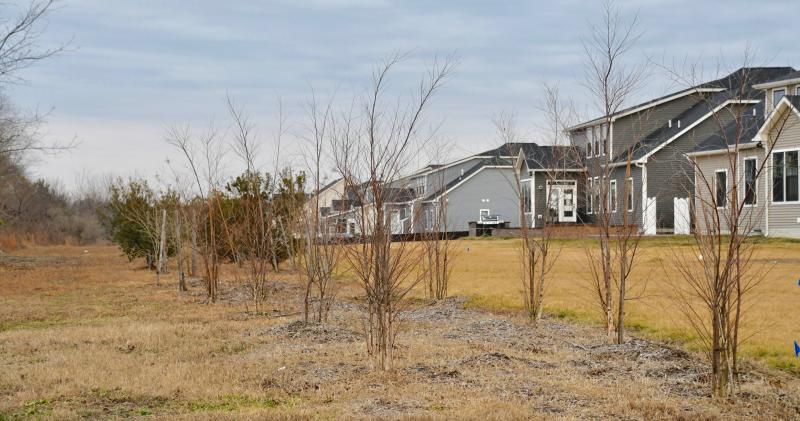Residents question Sussex cluster ordinance
Two residents appeared before Sussex County Council Feb. 7 with one message – rework the cluster subdivision ordinance.
Jill Hicks, who lives in Chapel Green near Lewes, showed council members a short video of equipment ripping out trees along her backyard property line to make way for the Brentwood (formerly known as Coral Lakes) cluster subdivision along Robinsonville Road.
She claims the mandated 30-foot forested perimeter buffer is less than 15 feet, which puts trees on her property at risk.
In addition, Hicks said, how open space is defined is questionable in the ordinance. She said stormwater ponds are utilities, and not passive open space. She also said wetlands and buffers should not be counted as open space. Hicks said open space should be contiguous and for the community's use.
In addition, she said, mature trees should be identified and preserved.
Jeff Seemans of Milton said there are four groups that do not understand the cluster ordinance – builders and developers, local engineer contractors, Sussex County Planning & Zoning Commission, and county council.
He said they do not understand the ordinance because its provisions for superior design and environmental protection are not followed.
“The cluster subdivision ordinance should be ripped up and started from scratch,” he said.
Councilman Doug Hudson said the cluster ordinance needs to have stronger regulations, especially related to the removal of trees. He said trees of a certain size in buffers should be off limits, and if a forested buffer area is clear-cut, a developer should wait five years before construction can begin.
“Planting saplings in a buffer is not a forested buffer," he said.
“I’m outraged at what I saw today, and if it’s not a violation of the ordinance, then the ordinance is not what I envisioned when we passed it,” said Councilman John Rieley. “We need to close any loopholes quickly.”
Council wants another look
Chip Guy, Sussex County communications director, said a notice of violation has not been served at this time because the removal of trees that were shown on the preliminary subdivision plan to be retained does not constitute a violation if no final approval has been issued.
“It will, however, require a landscaping plan to be included in the final subdivision plan, showing how any deficit in the required buffer’s depth is to be corrected,” he said. “Any new plantings are required to be in accordance with the height and caliper widths specified in the county code, and at the developer’s expense.”
Guy said council expressed concern that activity such as this, while possibly not constituting a violation at present, could still run afoul of the spirit and intent of the county code.
Guy said council has directed staff to look at further code amendments so situations like these do not occur in the future.
Tree removal at developer's risk
Sussex County Planning and Zoning Director Jamie Whitehouse said existing trees may be removed from a development site prior to final site-plan approval. “However, such a change would be at the developer’s own risk, as it would result in site conditions that are different from those shown on the approved preliminary subdivision plan. The consequence of making such a change is that any deficit will then need to be addressed by the applicant through the submittal of additional planting plans prior to any potential approval of a final subdivision plan,” he said.
About the ordinance
An amended cluster subdivision ordinance was passed a year ago.
Under the ordinance, on land served by central sewer service, developers can build on 7,500-square-foot lots using the cluster option instead of 20,000-square-foot lots for standard subdivisions in AR-1 zoning. Because of the advantages of smaller lots, nearly all subdivisions over the past decade have been constructed using the cluster option.
Cluster subdivisions:
• 7,500-square-foot lots instead of 20,000-square-foot lots in standard subdivisions
• Open space must be beneficial to residents and adjacent to either preserved lands, wetlands, parks, waterways, farmland or woods
• A pedestrian trail is required in open space with connection provided to any other existing trails
• Sidewalks on at least one side of all streets
• Central water and sewer
• Superior design elements: 30% open space in one contiguous land tract; preservation of existing wetlands, waterways, wildlife corridors, farmlands and woodlands as part of design; minimum 25-foot setback from wetlands; limited removal of trees; scenic views preserved to the greatest extent possible
• Developers receive expedited review
• Minimum buffer regulations include a 25-foot setback from all wetlands, 50-foot setback from tidal waters, streams and rivers, 30-foot forested buffer from farmland and 30-foot vegetated buffer from other developments
• Preservation of scenic views and natural and historic resources
• Homes must be clustered on the least environmentally sensitive areas of a parcel
• Developers are required to submit a report outlining lands to be preserved, developable areas, roads and trails, and where lots are located.






















































